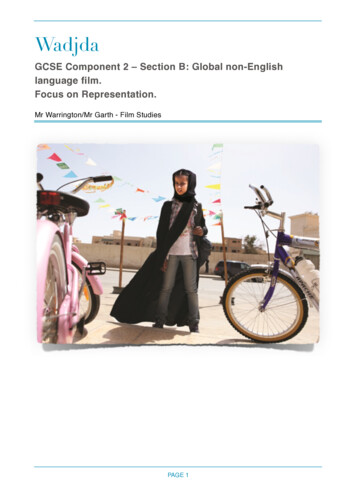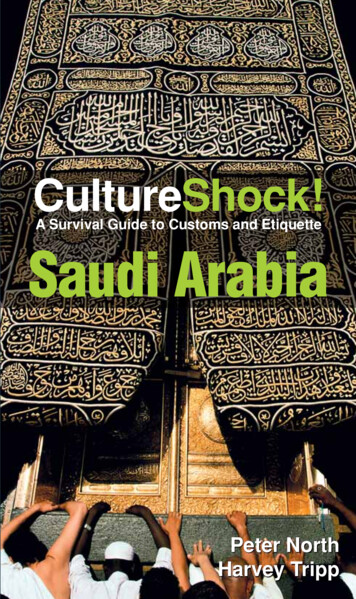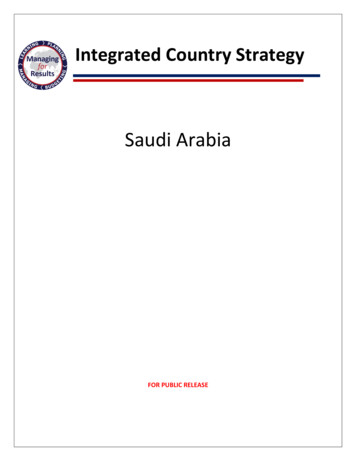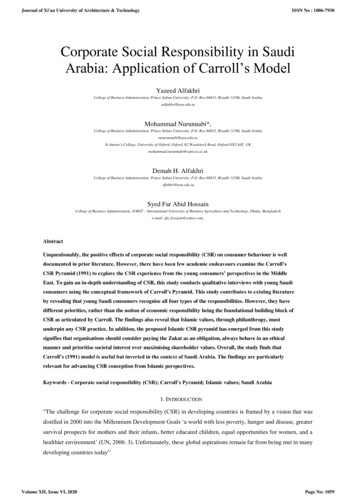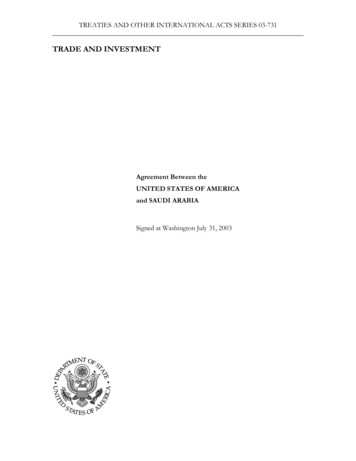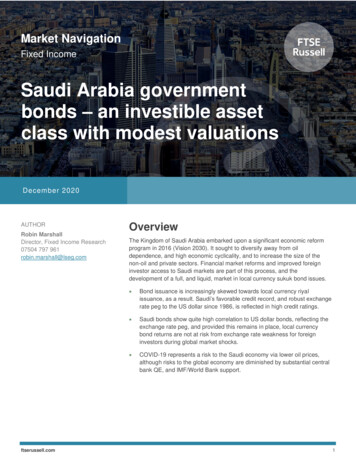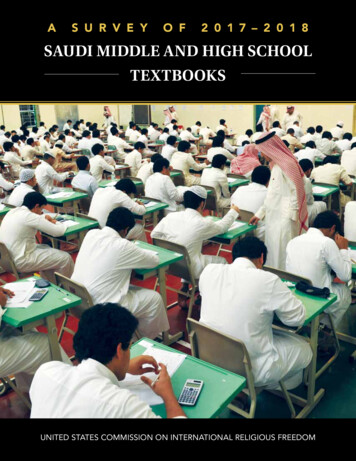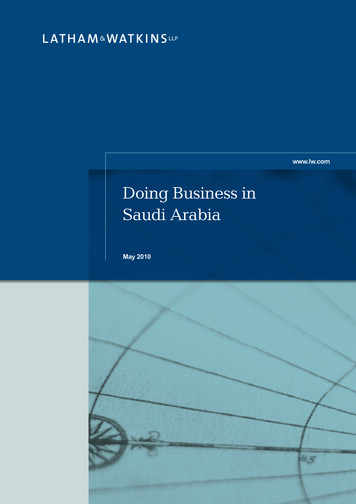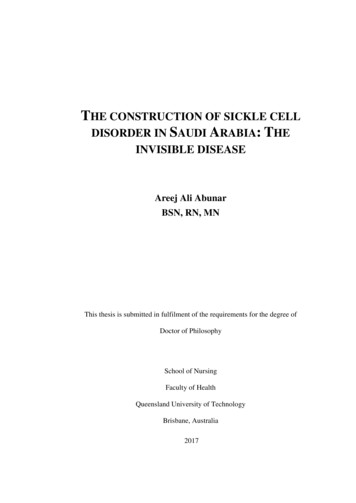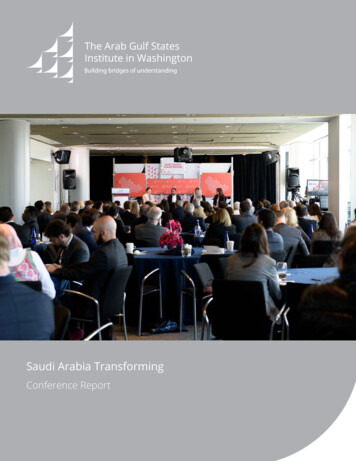
Transcription
Saudi Arabia TransformingConference Report
June 12, 2017Saudi Arabia TransformingConference Report
E v e n tR e p o r t#12017The Arab Gulf States Institute in Washington (AGSIW), launched in 2015, is an independent,nonprofit institution dedicated to increasing the understanding and appreciation of the social,economic, and political diversity of the Gulf Arab states. Through expert research, analysis,exchanges, and public discussion, the institute seeks to encourage thoughtful debate and informdecision makers shaping U.S. policy regarding this critical geostrategic region. 2017 Arab Gulf States Institute in Washington. All rights reserved.AGSIW does not take institutional positions on public policy issues; the views represented hereinare the author’s own and do not necessarily reflect the views of AGSIW, its staff, or its Board ofDirectors.No part of this publication may be reproduced or transmitted in any form or by any meanswithout permission in writing from AGSIW. Please direct inquiries to:Arab Gulf States Institute in Washington1050 Connecticut Avenue, NWSuite 1060Washington, DC 20036This publication can be downloaded at no cost at www.agsiw.org.Event Photos Credit: Kaveh SardariGetty Images
About This ReportThis report was compiled by Omar H. Rahman, a New York-based journalist and commentator,following the AGSIW conference “Saudi Arabia Transforming” held on May 10, 2017.Saudi Arabia has embarked on an ambitious program of national transformation aiming to diversifythe economy away from oil dependence, expand the private sector, and transform governmentpractice. Yet difficult challenges remain. AGSIW’s conference, “Saudi Arabia Transforming,” focusedon the key drivers reshaping Saudi Arabia, a year after the release of Saudi Vision 2030.Videos from the conference are available online at:www.agsiw.org/saudi-arabia-transforming/
ContentsWelcome Letter iExecutive Summary 1Key Findings and Recommendations 1Introduction 3A Conversation with Abdulaziz Al Sager 3Session 1 – Saudi Vision 2030: One Year Later 5Session 2 – Culture Shock: Saudi Vision 2030 and SocialChange 7Session 3 – Economic Transformation and Saudi Arabia’sGlobal Posture 10Conclusion 11Keynote Remarks by H.H. Faisal Bin Farhan Al Saud 13Agenda 17Saudi Arabia Transforming in Pictures 20
Saudi Arabia Transforming iWelcome LetterDear Colleagues,On behalf of the Arab Gulf States Institute inWashington’s board of directors and staff, it ismy pleasure to share with you the report of ourconference: “Saudi Arabia Transforming.”Ambassador Marcelle M. Wahba, President, AGSIWHosted on May 10, 2017, the conference brought together a distinguished group of expertsand officials to take a close look at the opportunities and challenges of Vision 2030, one yearafter its unveiling by Saudi Deputy Crown Prince Mohammed bin Salman.The Kingdom of Saudi Arabia has embarked on a very ambitious program of nationaltransformation with all the opportunities and challenges that it entails. Vision 2030 goes wellbeyond a reform or restructuring plan to diversify the economy away from dependence onoil. What is outlined in Vision 2030 and the National Transformation Program will have a muchbroader impact on the economic, social, and political life of Saudi Arabia – both in the shortand long term.It is easy to be skeptical of such ambitious visions that will require dramatic social change,threaten vested economic interests, and inevitably challenge established ways of doing things.This kind of deep structural change is all the more difficult in a conservative, traditional societyand culture. For all these reasons, this transformation will not be easy or smooth, but it isabsolutely necessary if Saudi Arabia hopes to secure a stable and prosperous future.I hope you find this conference report informative and useful, and I look forward to engagingwith you in the months and years to come.Sincerely,Ambassador Marcelle M. WahbaPresident, Arab Gulf States Institute in Washington
Saudi Arabia Transforming 1Executive Summary“Vision 2030 is not just a program for economic reform, it is a true effort at nationaltransformation.” - H.H. Faisal Bin Farhan Al SaudOn May 10, 2017, the Arab Gulf States Institute in Washington brought together thoughtleaders from the Gulf Arab states, Europe, and the United States to discuss Saudi Arabia at atransformational moment in its history, as the country advances its ambitious reform program– Vision 2030. With a clarity of purpose crystalized by the oil shock of 2014, a year ago the Saudigovernment initiated wide scale economic and public sector reforms aimed at diversifying itseconomy, rationalizing its public sector, reducing subsidies, stimulating the private sector,and restructuring its legal and regulatory framework. It also began taking steps to promotea stronger sense of Saudi national identity based on the country’s place as the center of theMuslim world, its unique historical and religious sites and heritage, and multiple other socialand cultural initiatives. All of this has been framed by immense regional challenges, a strategicrivalry with Iran, and a military engagement in Yemen that has sapped resources and requiredthe ultimate sacrifice from the kingdom’s citizenry.In the process, Saudi Arabia has created unavoidable social tensions that it will have tonavigate in the years ahead. The government has remained conspicuously silent on much ofthe social and cultural impact of Vision 2030, and the plan lacks clarity on how the governmentwill tackle these issues. The state must find ways to communicate effectively with its citizenry,incorporate more women into its workforce, and provide a space for open expression and aplatform for dialogue with the government and an entrenched, conservative establishment.Finally, Saudi Arabia will also need to increase its capacity to engage with a region in turmoilby strengthening both its military and diplomatic core, as well as developing and enhancingforeign relations and alliances.Key Findings and Recommendations The Saudi government must remain flexible in its implementation of Vision 2030. If it istoo rigid it will not be able to properly respond to the changing landscape – domestically,regionally, and globally. Success will require effective coordination, the managing ofexpectations, and developing rules that can allow policymakers to shift course dependingon the changing environment. Saudi Arabia must continue to increase its level of transparency and openness with themarkets, building up statistical capacity so data can be analyzed and disseminated. Thiswill allow the government to understand and respond to domestic progress and setbacks,promote foreign direct investment, and continue to raise debt on favorable terms. Rigid austerity measures are not the answer. Saudi Arabia is suffering from revenueconstraints from the low price of oil, but cutting government expenditures will only hurtthe private sector at a time when the government is trying to encourage the private sector’srapid growth.
Saudi Arabia Transforming 2 Change the relationship dynamic between the government and private sector, puttingboth on an equal playing field. Maintain dialogue with the beneficiaries of private sectorreform to continue to receive feedback that can be addressed through policy adjustments. Take proper advantage of the massive changes occurring in automation and newtechnology. Don’t pursue industries with limited shelf lives; look to the future. Equip youngpeople with the skills to survive in the future economy. When establishing industrial zones, thought must be given to overcoming constraintsand enabling backward linkages. Make sure these zones can employ Saudi nationals, andnot just cheap labor from abroad. Keep reforming the areas that have contributed heavily to building the deficit, especiallysubsidies. Establish a clear approach to the social and cultural impact of reforms. Empower civilsociety to act as a counterweight to conservative elements in society that have an entrenchedand dominant voice. Empowering women and bringing them into the workforce will be vital to the success ofthis project. Create a space for workers to voice their grievances. Saudi Arabia needs to continue to develop its capacity to respond to the challenges of theregion because the country has an important role to play. Enthusiasm and expectations for the administration of President Donald J. Trump inWashington must be managed carefully. Don’t overload the cart. Find an effective means to respond to Iranian aggression while also pursuing a positivecoexistence.
Saudi Arabia Transforming 3IntroductionThe downturn in global oil prices, which began in June 2014, has taken a tremendous toll onthe economies of oil exporting countries. While Saudi Arabia has been largely sheltered bythe vast fiscal reserves built during the preceding period of high oil prices, costly governmentexpenditures continue to erode those buffers and put enormous pressure on the finances ofthe kingdom. Moreover, Saudi Arabia’s ability to manage prices as a swing producer has beensignificantly compromised by a revolution in shale oil production in the United States, makingits long-term reliance on crude oil sales unsustainable.In response, King Salman bin Abdulaziz launched a sweeping economic reform programin April 2016 aimed at liberating the Saudi economy from the volatility of oil markets.Spearheaded by Deputy Crown Prince Mohammed bin Salman, the Vision 2030 program hasbroad economic, social, and political implications that will move the country into a new era.But reforms are not taking place in a vacuum. Saudi Arabia must also navigate an increasinglydangerous neighborhood, a regional rivalry with Iran, and a more volatile and competitiveenergy landscape that has diminished its resource base.A Conversation with Abdulaziz Al Sager“You cannot bring about an economic change withouta political and social change.” – Abdulaziz Al SagerThe “Saudi Arabia Transforming” conference began with a conversation between AGSIWSenior Resident Scholar Hussein Ibish and Abdulaziz Al Sager, chairman of the Gulf ResearchCenter. The two discussed a number of themes that set the stage for the conference, includingthe overall goal of Vision 2030, along with the economic, social, and political implications ofthe plan; prospects for restored relations with the United States during the presidency ofDonald J. Trump; and Saudi Arabia’s stances on combating terrorism in the Middle East andthe kingdom’s confrontation with Iran.Sager identified economic diversification as one of the key pillars of Vision 2030, as thegovernment attempts to break Saudi Arabia’s reliance on hydrocarbon revenue by expandingthe private sector, encouraging foreign direct investment, and increasing the role of state-runagencies that invest domestically and abroad.The hallmark initiative of Vision 2030 is the partial public offering of Saudi Aramco, the nationaloil company and engine of the Saudi economy. Through an initial public offering expected in2018 that Aramco projects could be worth 2 trillion, Saudi Arabia hopes to pivot Aramco intoan international conglomerate, while turning the state-owned Public Investment Fund intoone of the largest sovereign wealth funds in the world. The Saudi government also announcedthe National Transformation Program in 2016, setting an interim target of 2020 for severalpublic sector initiatives aimed at restructuring the government. Through these reforms, andthe use of public-private partnerships, the Saudi government is hoping to stimulate foreigndirect investment in a number of promising sectors of the Saudi economy, including healthcare, telecommunications, infrastructure, power generation, and water desalination.
Saudi Arabia Transforming 4Sager acknowledged that such economic reforms are not possible without inducing socialand political change. “No changes will happen without difficulties, and no changes will happenwithout real challenges,” he said. “But once those challenges have been identified, we arewilling to deal with it.” While pointing to the increasing visibility of women in the political andeconomic life of the kingdom, Sager cautioned that social change should be allowed to occurgradually and without interference or imposition of foreign values.A New PartnershipSince Trump won the U.S. presidential election in November 2016, the Saudi leadership hasbeen very optimistic for the relationship between Saudi Arabia and the United States. TheSaudi leadership sees an affinity with the Trump administration on a number of key issues,including combating terrorism and containment of Iranian expansion, as well as cooperationon Yemen, Syria, and Iraq. The Saudi government feels it has suffered from 16 years of U.S.policies in the Middle East under Presidents George W. Bush and Barack Obama, includingthe destabilizing impact of the 2003 U.S. invasion of Iraq and then a “policy of reluctance”embodied by Obama in the region. Accordingto Sager, these diametrically opposed foreignpolicies – interventionism and retrenchment– have resulted in the birth of the IslamicState in Iraq and the Levant, encouragedIran’s imperial inclinations, and returnedRussia to a central role in the region’s affairs.Sager believes that, based on Trump’sstatements before and after the election, itcan be inferred that Trump will try to reversethe policies of his predecessors and commitresources to guaranteeing the “vested andvital interests of the U.S. in the region,” aswell as those of its Gulf Cooperation CouncilAbdulaziz Al Sager, Chairman, Gulf Research Centerpartners. Trump delivered an importantsignal to the region in Syria when he responded to a chemical weapons attack against civiliansby the regime of President Bashar al-Assad with a cruise missile attack on a strategic airbase.Saudi Arabia hopes this move will be expanded upon and that the United States will even beable to pressure Russia into bringing the Syrian civil war to an acceptable settlement.Looking to the broader region, Saudi Arabia views political instability and the proliferationof terrorism as a major threat to the kingdom and its allies. Sager pointed to Iraq, Syria,Libya, and Somalia as incubators of terrorism with which Saudi Arabia is forced to contend.In December 2015, Saudi Arabia, under the auspices of Minister of Defense Deputy CrownPrince Mohammed bin Salman, announced the formation of the 34-country Islamic MilitaryAlliance to Fight Terrorism, which notably did not include Iran, Iraq, or Syria. While details ofthe alliance’s mission and directives have been thin, Sager said the initial purpose will be forsharing intelligence. There will be a cyber component to monitor social media and identify andshare pertinent information among governments, as well as a military unit, led by the ex-headof Pakistan’s military, Gen. Raheel Sharif. Finally, the alliance will be tasked with encouraging
Saudi Arabia Transforming 5moderate Islam and opposing extremism within the practice of the religion.Session 1 – Saudi Vision 2030: One Year Later“The biggest opportunity here is that there is a real demand that’s coming up with thischange, which is effected by this real unparalleled political will.”– Khlood AldukheilDuring the opening panel session, Khlood Aldukheil, executive vice president of AldukheilFinancial Group; Elena Ianchovichina, lead economist for the Middle East and North Africa at theWorld Bank; and Alia Moubayed, director of geo-economics and strategy at the InternationalInstitute for Strategic Studies, explored the progress made by the Saudi government duringthe first full year of implementation of Vision 2030. Facing extraordinary economic pressure asa result of sustained, low oil prices, Saudi Arabia has introduced far-reaching reform policies,raised debt, and enacted austerity measures that may not have been possible previously.In the process, some of these austerity measures – such as cutting public sector benefitsand freezing infrastructure projects – hurt the consumer economy and damaged parts of theprivate sector at a time when the government was also trying to stimulate its growth. Thegovernment has been responsive, however, and has left itself room for flexibility, which wasconsidered by the panelists as one of the greatest strengths of the Vision 2030 program.While Vision 2030 is broad in scope, including policies aimed at strengthening nationalidentity, increasing health care benefits, and providing a greater space for nongovernmentalorganizations, the plan remains predominately economic in nature. This economic componenthinges on expanding and diversifying the private sector, raising non-oil sector revenue,and increasing employment levels for Saudi nationals. In a headline-grabbing gesture, thegovernment announced plans to offer partial-ownership of the crown jewel of the Saudieconomy, Saudi Aramco. The government also introduced the National TransformationProgram aimed at restructuring the public sector and achieving fiscal balance by the interimdate of 2020.1The panelists saw this this latter effort as the greatest milestone of the past year in reducingthe budget deficit through subsidy reform. The government has already raised the price ofgasoline substantially and was expected to eliminate fuel and water subsidies, while providingcash transfers to vulnerable citizens. Panelists also pointed to changes to the regulatory andlegal framework to encourage public-private partnerships and foreign direct investment as apositive step.Vision 2030 is not without obstacles. The sheer magnitude of the reforms and the limited timeframe set to achieve them will likely keep some targets out of reach. Many of the obstaclesare structural and will take a generation of work to fix. Across the board, the panelists pointedto the human factor – having a citizenry both ready and capable of significant change – asthe biggest challenge facing the implementation of Vision 2030. According to Aldukheil, the1 “Fiscal Balance Program,” Vision 2030: Kingdom of Saudi Arabia, accessed June 1, 2017.
Saudi Arabia Transforming 6central obstacle is “a lack of qualified human resources who have the knowledge and skill toactually effect the change of the vision.”Success will require private sector growth and an improved education system to movesimultaneously and complement each other by providing both the job opportunities as well asthe skilled labor force to fill them. “If private sector growth picks up and the quality of educationimproves to equip the young entrants into the labor market needed by the companies, thenwe will have a very positive spiral of growth, which would enable the realization of the vision,”said Ianchovichina. As the government decides to rationalize the public sector to createa more efficient government, it will, in so doing, limit the amount of jobs available. If it isnot able to simultaneously stimulate growth in the private sector that will provide enoughjobs, this will create a pool of unemployed workers and create problems. “It is a very gentlebalancing act, where it will involve focus on youth to address managing expectations, timingof reforms, coordination of reforms, butalso collecting data of a different nature tomonitor progress,” Ianchovichina added.In addition to youth, the Saudi governmentmust also strive to empower women byincluding them in the workforce. Currentunemployment rates for women in SaudiArabia are around 36 percent, with Saudiwomen having one of the lowest workforceparticipation rates in the world, according toa panelist. Propelling the economy forwardto meet the goals of Vision 2030 will beimpossible without greater inclusion ofKhlood Aldukheil, Executive Vice President, Aldukheil Financial Groupwomen. Saudi Arabia will also have to managethe potential creation of new social inequalities, something to which it is already sensitive.Panelists said the government can manage this by regularly surveying the population andadjusting policies accordingly. Indeed, a well-crafted communication strategy with the Saudipopulation will be essential to getting the people on board and mitigating social and economictensions. All the panelists stressed the importance of compiling, analyzing, and distributingdata in order to maintain transparency for the sake of the government and investors.Relations between the private sector and the government are undergoing a transition and itwill be important to find a proper level of parity and communication, where the private sectoris not simply viewed as a customer of the government. For example, when the governmentinstituted austerity measures during the rollout of Vision 2030, steps were taken that hurtthe private sector at a time when private enterprise was supposed to be growing. Slashinggovernment expenditures, for example, damaged the contracting industry. The governmentcancelled future projects to reassess what was a priority, and in so doing, accelerated theslowdown in the economy. The private sector was able to effectively voice its concerns to thegovernment, however, and actions were taken to resolve the situation.Through expanding the private sector, the government has also set about trying to limitcurrency outflows in sectors such as defense and health care through an industrial policy of
Saudi Arabia Transforming 7import substitution. The panelists, however, warned of the pitfalls of “picking winners” amongindustries. They stressed that careful consideration must be given to competitive advantagesand overcoming key constraints, especially in the redevelopment of economic zones. Whilethe obstacles are numerous, Saudi ArabiaThrough expanding the private sector, the governmentalso has several advantages. First andforemost is the coherence of purpose has also set about trying to limit currency outflows inand the evident will of the leadership to sectors such as defense and health care through animplement these changes. The countryindustrial policy of import substitution.also does not have entrenched industriesand a labor force that will suffer from the major shifts occurring globally with automation andnew technology. The government also has substantial financial resources to invest and a stablepolitical environment that is safe for foreign investment. While other countries must “remodelan old home,” in the words of Ianchovichina, Saudi Arabia can build “a new structure.”Session 2 – Culture Shock: Saudi Vision 2030 andSocial Change“ in the lack of clarity for social and cultural change in this plan, there is an opening fora lot of tension and possible conflict between how different groups in society see whereshould this cultural and social change go.” – Ahmed Al OmranWhile Saudi Vision 2030 is predominately an economic reform plan, it also has socialcomponents that include promoting the arts, entertainment, sports, and nongovernmentalorganizations, as well as reinforcing Saudi national identity. Moreover, the ambitious economicreforms outlined in the program cannot come to fruition without creating new social, cultural,and political tensions in Saudi society that must be addressed.During the second panel session, AGSIW Visiting Scholar Hala Aldosari, Saudi Shura CouncilMember Lina K. Almaeena, and journalist Ahmed Al Omran established that many of the socialchanges underway in Saudi Arabia preceded Vision 2030, but noted that the framework fornational transformation can still provide an important vehicle for advancing social and culturalchange. The panelists agreed that more important than introducing any single social reformpolicy is having an overall vision of where to take the country. While this is still lacking, thesimple desire and intent to pursue change and transform Saudi society is welcome.When it comes to the implications of the program, however, Vision 2030 is ultimately silent onhow the government and society will manage the frictions and sticking points that are bothobvious and unforeseen. For example, Vision 2030 is clear in the intention to incorporatemore women in the workforce, increasing participation from 22 to 30 percent. At present,women often lack the autonomy to be full-fledged participants in the workforce, accordingto Aldosari. All the impediments to a more active role for women in the economy, includingthe availability of day care and the ability to drive cars, mix publicly with the opposite sex, andmake decisions without the permission of a male guardian, are not discussed in the programand the government has not communicated to the people how it intends to square this circle.
Saudi Arabia Transforming 8Another clear example of setting reform goals while leaving questions unanswered is thepromotion of Saudi Arabia’s contemporary art scene. “It is more pressing there, because youhave a society where there is a very conservative culture that is common, and for artists tochallenge that culture and try to break out of it, that will definitely lead to conflict and a reaction,”Omran said. “It will be very interesting to see how the government decides to react to it.” Whilethe government has not faced much opposition thus far, as it continues to grow and develop,Omran asked where the government will stand on conflicts over artistic expression. How farwill artists be able to push cultural boundaries? And will there be restrictions on the type of artproduced or where it can be displayed? Once again, all of these questions remain a mysteryin regard to government policy and the scope of reform envisioned by the Saudi leadership.This discrepancy between clarity on the economic front and silence on the social front maydemonstrate a tendency by the government to want to avoid confrontation, or prioritize socialpeace over social change. It may also presuppose an inclination to back down if any social orcultural outcome of Vision 2030 generates some form of public opposition. Panelists felt thatreformers in the government have done little to challenge hard-liners and moderate the morereactionary segments of society and government. In this regard, establishing a strong civilsociety will be fundamental to reform, acting as a vocal counterweight to the conservative,religious establishment that dominatesthe social space. A strong civil society will While it is easy to calculate how much money can bealso ensure that the government is notsaved from reducing subsidies, it is far more difficultthe sole initiator, executor, and arbiter ofto determine the impact on the relationship betweenreform in the country.the government and the people.Some panelists pointed to economicpolicies that also have important socialcomponents, such as subsidy reform. While it is easy to calculate how much money canbe saved from reducing subsidies, it is far more difficult to determine the impact on therelationship between the government and the people. More importantly, as the welfare stateis scaled back and the economy becomes more reliant on the production of private citizens, willa new social contract develop? One point of contention between the panelists was over howmuch influence the young generation will have in pushing reform. Saudi youth – who make uptwo-thirds of the population2 – are overwhelmingly present online, exposed to the world in away previous generations were not, and increasingly taking ministerial level positions in thegovernment.Among the changes generated from this is the growing presence of government officialson social media platforms. While the government’s first instinct had been to censor socialmedia, it now sees engaging in the conversations online as a better option. But panelists alsonoted the entrenchment of older generations in government and the economy, stating thatadvancing progressive reforms will not be straightforward simply because young people makeup a majority of the country or that the older generation is part of the digital landscape.Certainly, the government has made some important accomplishments, including limiting the2 Luay Al-Khatteeb, “Saudi Arabia’s Economic Time Bomb,” Brookings Institution, December 30, 2015.
Saudi Arabia Transforming 9power of religious police to harass citizens in public. When it comes to women’s participationin society, Almaeena pointed to a gradual increase over several years and across sectors,saying it is important to consider that until 2001 women could not access a national ID card,while today they are members of the Shura Council, the highest advisory council to the king.While pushback on reform is inevitable, the government has shown some perseverance in itssocial reform goals. One example that has received conservative opposition is the introductionof more entertainment options for the public, including cinema and live music. In 2016, anentertainment authority was established with the support of the deputy crown prince to helpimprove quality of life in Saudi Arabia. Butcertain segments of society have respondednegatively, including the grand mufti, whocame out against the introduction of suchentertainment options. In response, thegovernment treaded the line delicately, but itappears to be moving forward nevertheless.While some panelists felt that conservativeelements might be hesitant to oppose everyinstance of social reform, especially with theweight of the royal family behind it, they couldpresent a more significant challenge overentrenched interests and power structuresin other segments of society. The legal andLina K. Almaeena, Shura Council, Kingdom of Saudi Arabiajudiciary sector, in particular, has been themost resistant to change, according to the panelists. Judges enjoy very wide discretion and thegovernment has found itself in an awkward position as it tries to reform the judiciary. Thereis also some resistance from within the government to try and force change too quickly to aninstitution that needs stability
2018 that Aramco projects could be worth 2 trillion, Saudi Arabia hopes to pivot Aramco into an international conglomerate, while turning the state-owned Public Investment Fund into one of the largest sovereign wealth funds in the world. The Saudi government also announced
